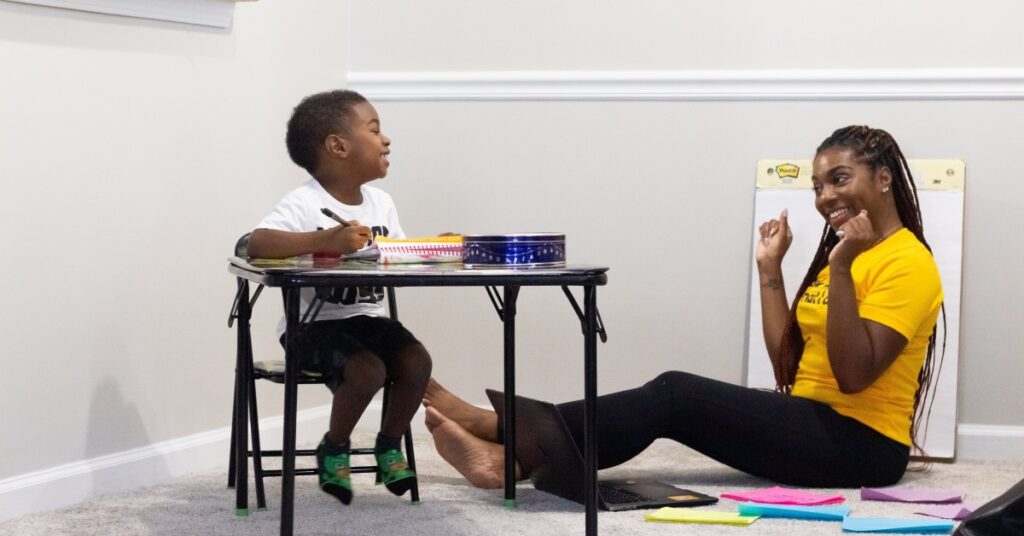
What Is a Master of Library and Information Science?
all LIS professionals must be information-literate. They can work in [...]
If you have a young child with a learning difference, you probably know you’re entering the land of educational acronyms.
Sitting at your first — or even second or third — meeting with your child’s special education teacher and service providers can be intimidating enough, especially when you’re trying to keep track of all of the acronyms being tossed around. You might be the type of person who asks what each one means as it comes up, or you might be someone who lets the conversation flow so you can catch as much as possible in the moment.
You’ll probably give yourself an internal high-five once you master the first round of terms, but unfortunately, there may be others that get dropped into the conversation once your child moves on to elementary, middle, or high school.
Fear not! Check out Noodle Expert Abbie Mood’s helpful guide to the 65 most commonly used acronyms in the realm of special education, including links to articles and other resources to enable you to learn more.
Numbers
A–D
E–H
I–L
M–P
R–U
V–Z
| University and Program Name | Learn More |
|
Merrimack College:
Master of Education in Teacher Education
|
AAC (Alternate Augmentative Communication]: A broad term that refers to forms of communication other than oral that may be used to add to or replace speech for individuals with [disabilities related to spoken or written language.
ADA (Americans with Disabilities Act{: target=”_blank” }): Signed into law in 1990, this act prohibits discrimination against people with disabilities, ensuring that they have the same opportunities as non-disabled individuals in everything from access to public spaces to employment.
ADD/ADHD (Attention Deficit Disorder/Attention Deficit Hyperactivity Disorder]5{: target=”_blank” }): While both acronyms have been used in the past, [ADHD is presently the generally accepted term to describe an individual who has difficulties with attention, impulsivity, and overactivity.
APE (Adapted Physical Education{: target=”_blank” }): Modified Physical Education program for children with disabilities.
ASD (Autism Spectrum Disorder]7{: target=”_blank” }): The term used to describe a diagnosis of [autism. While there are many different characteristics of autism, and a wide range of abilities within the diagnosis, it is typically characterized by one or more of the following: cognitive and/or language delays, difficulties in motor coordination, physical health issues, and/or lack of appropriate social skills.
ASL (American Sign Language): The predominant language of people in deaf communities in the United States and Canada.
AT (Assistive Technology{: target=”_blank” }): Any device that helps a student with disabilities. This can range from a computer to a special pencil grip.
AYP (Adequate Yearly Progress]9{: target=”_blank” }): Taken from the No Child Left Behind Act (NCLB), this acronym refers to the annual improvement required for students in K–12 schools as measured by math and reading scores on [state assessments. It should be noted that more and more states are applying for and being granted waivers from NCLB requirements, enabling them to design their own criteria for measuring educational progress among their students.
BIP (Behavior Intervention Plan]10{: target=”_blank” }): A plan that is created by the [IEP team based on the results of the FBA (see below) that includes the reasons for the specific behaviors, as well as planned interventions.
CCSS (Common Core State Standards]11{: target=”_blank” }): Grade-level educational standards that are used for K–12 schools in states that have adopted these [standards.
CD (Cognitive Disability): A developmental delay that indicates a child is not meeting the typical milestones in learning, understanding, reasoning, and problem-solving.
CF (Cystic Fibrosis{: target=”_blank” }): A disease that affects the secretory glands and causes mucus to become thick and sticky, building up particularly in the lungs and resulting in blocked airways, which can, in turn, cause repeated lung infections and eventually lung damage.
CP (Cerebral Palsy{: target=”_blank” }): Typically caused by damage to the brain before or just following birth, it causes a physical disability that affects a person’s control and coordination of muscle movements.
DB (Deaf-Blind): Refers to a child who is both deaf and blind.
DD (Developmental Delay): When a child is not meeting typical milestones in a particular developmental area, such as cognitive, physical, fine motor, or psychosocial.
DS (Down Syndrome{: target=”_blank” }): Also known as trisomy 21, this disorder occurs when a person is born with a partial or full extra copy of chromosome 21. There are some common characteristics among children diagnosed with Down Syndrome, but each child has a range of abilities and health challenges.
DSM (Diagnostic and Statistical Manual of Mental Disorders]15{: target=”_blank” }) by the American Psychiatric Association: The standard manual used by mental health professionals in the United States to describe and diagnose [mental disorders.
EBD/ED (Emotional Behavioral Disability): A diagnosis for children who exhibit extreme, severe, and frequent behaviors that interfere with their learning and which cannot be explained by health, sensory, or cognitive factors.
ECE (Early Childhood Education): The branch of education that encompasses young children from birth to approximately 8 years of age.
ECSE (Early Childhood Special Education): The branch of education that supports infants, toddlers, and young children up to 8 years old who have a disability.
EI (Early Intervention{: target=”_blank” }): Services that help babies and toddlers, typically up to the age of 3 years, with developmental delays or disabilities.
ELL/ESL (English Language Learner/English as a Second Language): Children who aren’t yet able to communicate or learn in English, typically because they have been raised in a non-English-speaking household.
ESD (Extended School Day): A longer school day than is typically provided, and which is designed to meet the needs of students who need more instructional time than some of their peers.
ESY (Extended School Year): Educational programs provided beyond the regular school year to reduce regression of a student’s skills during school breaks.
FAPE (Free/ Appropriate Public Education{: target=”_blank” }): A provision of the Americans With Disabilities Act that ensures access to appropriate educational services at no charge to children with disabilities.
FAS (Fetal Alcohol Syndrome{: target=”_blank” }): A disorder that occurs as a result of prenatal alcohol exposure and which is characterized by particular facial features, growth deficiency, and neurobehavioral disorders.
FBA (Functional Behavior Assessment{: target=”_blank” }): An assessment to determine the underlying reason(s) for which a child is engaging in certain dysfunctional behaviors.
FERPA (Family Educational Rights and Privacy Act{: target=”_blank” }): A federal law that protects the privacy of student records and outlines parental rights regarding access to and use of these records.
GE (General Education): The typical educational programming that all non-disabled and some disabled students receive.
GT (Gifted and Talented]21{: target=”_blank” }): Children who demonstrate unusually high ability in academic, creative, or artistic skills and who have often undergone formal assessments to establish their eligibility for [educational programs designed specifically to meet their learning needs.
HI (Hearing Impaired): A child who isn’t considered deaf but has a hearing impairment that impacts learning.
HoH (Hard of Hearing): A hearing impairment that affects a child’s ability to learn but is not as severe as deafness.
IDEA (Individuals with Disabilities Education Act{: target=”_blank” }): A federal law that ensures services for individuals with disabilities from birth to 21 years.
IEP (Individualized Education Program): The educational plan created by a child’s teachers, learning specialists, and parents to meet the needs of a child who has been diagnosed with a disability. Such plans outline all of the supports and services that a child is eligible to receive and must be reviewed and updated on a regular basis.
IFSP (Individual Family Service Plan): The plan created by a family and disability service providers for a child from birth to 3 years of age who has developmental delays.
ITP (Individual Transition Plan): A component of the IEP that addresses long-term goals for the student.
LEA (Local Education Agency): Typically, a school district or government agency that provides or oversees education services in a community, including those for children with disabilities.
LEP (Limited English Proficiency): A designation for children who are English language learners (ELL).
LRE (Least Restrictive Environment): The most appropriate educational placement for a child with a disability, whether this is in an inclusive setting or a self-contained special education classroom.
MD (Muscular Dystrophy{: target=”_blank” }): A hereditary disorder that causes increasing muscle weakness.
MR (Mental Retardation): Below-average cognitive ability coupled with an inability to perform skills necessary for daily living.
NCLB (No Child Left Behind): An elementary and secondary education act designed to hold schools accountable for children’s learning and progress.
OCD (Obsessive Compulsive Disorder{: target=”_blank” }): A disorder that causes obsessions and compulsions and results in severe anxiety.
ODD (Oppositional Defiant Disorder{: target=”_blank” }): A disorder that results in a child demonstrating repeated defiant and hostile behavior towards adults. Such a condition is considerably more extreme than just “bad” behavior.
OHI( Other Health Impairment{: target=”_blank” }): This term is usually applied to a child whose ability is affected by another health condition, such as asthma, leukemia, or diabetes, among others.
OI (Orthopedic Impairment{: target=”_blank” }): An impairment that affects a child’s mobility, either related to birth defects, disease, or another cause.
OT (Occupational Therapy): A type of therapy that helps children who have developmental delays or physical disabilities (or both) with their daily living skills. Services may focus on feeding or eating issues, fine motor skills, sensory issues, and other challenges.
PBIS (Positive Behavioral Intervention and Supports{: target=”_blank” }, formerly PBS): A proactive approach that relies on positive reinforcement strategies to identify the reason for a particular behavior and offers interventions to help a student learn what is appropriate behavior.
PD (Physical Disability): Physical or mobility difficulties that interfere with a child’s ability to participate in regular school routines.
PDD (Pervasive Developmental Disorder{: target=”_blank” }): Once considered a subtype of autism, PDD refers to delays in a range of basic functions, including communication and social skills.
PT( Physical Therapy): Therapeutic services that concentrate on improving gross motor functioning in children with physical delays or individuals who have a physical impairment resulting from an injury or neurological event.
RtI (Response to Intervention{: target=”_blank” }): A screening process to identify and provide early learning and behavioral support to children before a full evaluation for disability services is conducted.
SAP (School-Aged Parents): Parents of school-aged children.
SB: (Spina Bifida{: target=”_blank” }): A birth defect in which the spinal column doesn’t fully close while a fetus is developing in the womb, and which can cause paralysis of the lower body.
SDD (Significant Developmental Delay): A term applied to children who have more than a mild or moderate delay in development.
SEA (State Educational Agency): The governmental body that oversees education policy and services within a state.
SELPA (Special Education Local Plan Area): A local plan to coordinate special education services among school districts in order to provide appropriate supports to children and adults with disabilities from birth to 22 years.
SLD (Specific Learning Disability (formerly LD)]32{: target=”_blank” }): A learning disability that affects the processing, understanding, or use of language or mathematical skills, such as [dyslexia, aphasia, dyscalculia, and so on.
SLI (Speech/Language/ Impairment{: target=”_blank” }): A delay in speech and language development.
SLP (Speech/Language Pathologist]34{: target=”_blank” }): A professional who works with children with speech or language delays, as well as [executive function disorders, autism spectrum disorders, and certain math disabilities, among others.
SpEd (Special Education): Educational services for children and students who require different learning approaches or accommodations than are provided by a general education teacher. Such supports may be offered to children with learning disabilities as well as those with exceptionalities that result in accelerated skills and knowledge.
TBI (Traumatic Brain Injury): An injury resulting from an external force that causes either permanent or temporary impairment to the brain that may lead difficulties with cognitive or physical functions.
TS (Tourette Syndrome{: target=”_blank” }): A neurological disorder that causes “tics,” or repetitive, involuntary movements or vocalizations.
Questions or feedback? Email editor@noodle.com

all LIS professionals must be information-literate. They can work in [...]

Elective courses can customize your MLIS degree to a career [...]

Do you intend to work in your community's public library [...]

For decades now, libraries have been attuned to new developments [...]

A more diverse teacher workforce could provide a key to [...]
Categorized as: Special Education, Education & Teaching